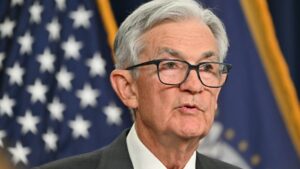Navigating Inflation and Interest Rates: Insights from Jerome Powell
In a recent address that has reverberated across financial markets, Federal Reserve Chair Jerome Powell shared his insights on the potential economic effects of President Donald Trump’s newly announced tariffs. With a focus on keeping inflation in check, Powell acknowledges the uncertainty in the current economic climate stemming from these trade policies.
The Impact of Tariffs on Inflation and Economic Growth
In his speech delivered to business journalists in Arlington, Virginia, Powell emphasized the Fed’s responsibility to maintain stable inflation expectations amidst a "highly uncertain outlook." He articulated concerns that Trump’s 10% across-the-board tariffs could lead to both inflationary pressures and lower economic growth. The Fed’s approach, he remarked, will be to wait for clearer indicators of how these tariffs will influence the economy before implementing any interest rate adjustments.
Dominating the conversation at the moment is the question of whether the Fed can effectively mitigate the inflationary effects of tariffs without resorting to significant cuts in interest rates—a strategy that some market participants are already anticipating. According to CME Group data, many analysts are pricing in potential interest rate reductions by mid-year, with expectations of at least a full percentage point cut by year-end.
The Balancing Act: Inflation Control and Employment
Powell underscored that the Fed’s dual mandate is not just about maintaining stable prices but also promoting maximum employment. However, with the recent uncertainty surrounding tariffs, which many economists consider major market disruptors, Powell highlighted the difficulty of keeping inflation expectations grounded. There’s a continual push from both economic participants and political actors for the Fed to respond quickly to signs of inflation, yet Powell asserts the need for a prudent and well-considered approach.
One of the core messages from Powell was the importance of viewing tariffs—despite their immediate effects—as potentially temporary increases in price levels. However, he cautioned that the sweeping nature of these tariffs could result in longer-lasting inflationary pressures, urging a careful assessment of their impacts.
Current Economic Indicators: Mixed Signals
Despite heightened concerns surrounding inflation, Powell noted that the economy is still "in a good place," characterized by a solid labor market. However, he also acknowledged recent consumer surveys that indicate growing anxiety over rising prices, coupled with decreasing expectations for future economic growth. While core inflation is presently running at an annual rate of 2.8%—exceeding the Fed’s target of 2%—the central bank’s strategy will prioritize long-term stability over short-term reactions.
At Extreme Investor Network, we believe that understanding the nuances of monetary policy is essential for making informed investment decisions. As the Fed navigates this challenging landscape, investors should keep a close eye on both policy announcements and the broader economic indicators.
Final Thoughts
In conclusion, Powell’s remarks present a clear picture of the Fed’s cautious stance in the face of uncertainty. As tariffs rattle the markets and inject unpredictability into inflation forecasts, staying informed will be critical for investors looking to navigate these turbulent waters. At Extreme Investor Network, we are committed to providing timely insights and expert analysis that empower our readers to make savvy investment choices.
For further information and ongoing updates on this evolving topic, be sure to subscribe to our newsletter and follow our updates. Empower yourself with the knowledge to thrive in today’s complex financial world with Extreme Investor Network!

